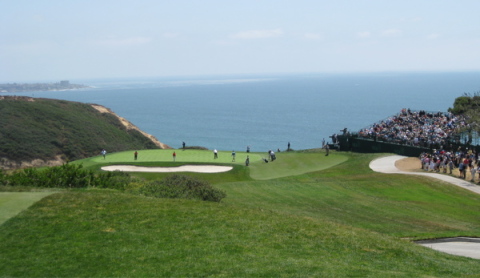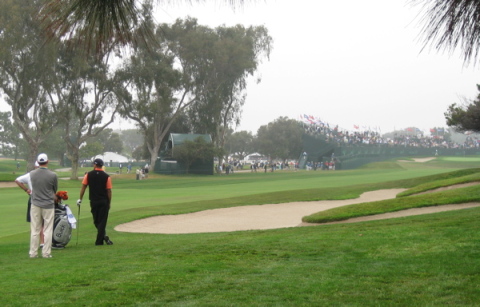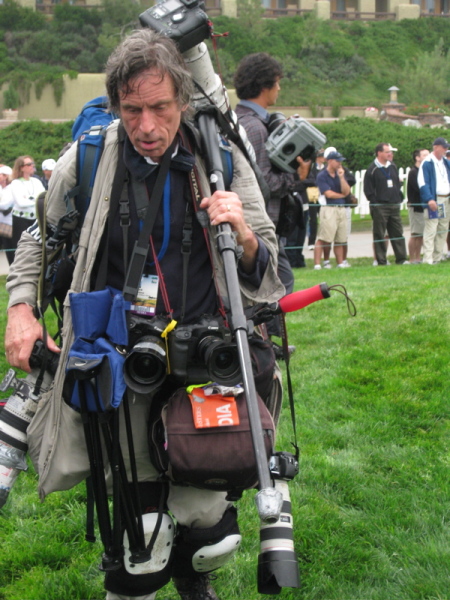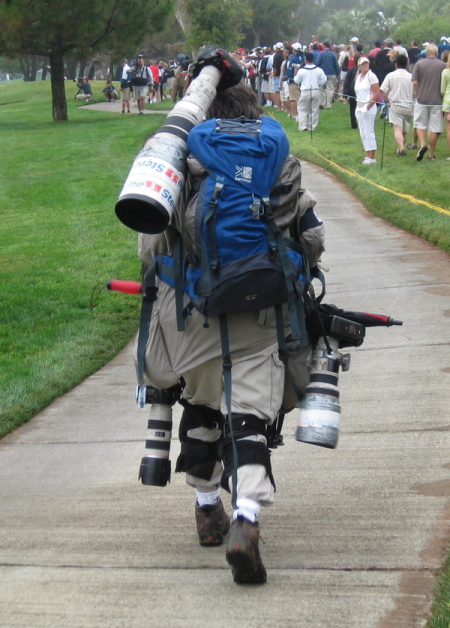Torrey Story: First Round Preview
/ Several new posts have been put up, including an explanation about the state of the bunkers, a look at the 18th hole and a preview of Thursday's setup.
Several new posts have been put up, including an explanation about the state of the bunkers, a look at the 18th hole and a preview of Thursday's setup. When one comes to the quality of the bunkers and other hazards we pass into realm of much dispute and argument. Primarily bunkers should be sand bunkers purely, not composed of gravel, stones or dirt. Whether this or that bunker is well placed, has caused more intensely heated arguments outside of the realms of religion, than has ever been my lot to listen to. C.B. MACDONALD

Available via Amazon (US): Golf Architecture For Normal People
Barnes And Noble (online and in stores)
Bookshop.org option to support local independent bookstores.
Reviews:
"Golf Architecture for Normal People . . . should be required reading for those who are not ashamed to admit they know little about the subject, and for those who think they do . . . . Golf course architecture geeks have trouble slimming their thoughts down to bite-sized chunks, but Shackelford has achieved a remarkable success here." —Independent (Ireland)
"From the relative newcomer who’s slowly getting hooked to those that have played the game for most of their lives and think they know a thing or two, Golf Architecture for Normal People provides a solid and sober perspective that will help everyone recognize why some golf courses are worth playing more than once while a single trip around others is all you’re ever likely to want or need." —Links Magazine.
“It’s a wonderful book. An easy read that arrives just in time for your summer reading list. If you’ve never thought about how an appreciation for course design could heighten your enjoyment of the game, you must check this out.”—The Peterborough Examiner
"As in his prior publications, in his newest book Shackelford shows a deep appreciation for what can be done to create a golf course that appeals to the broadest possible golfing audience…Shackelford’s prose is succinct, often witty, and accessible."—Cape Gazette
"Author, blogger and golf architecture expert Geoff Shackelford, who helped Gil Hanse design Rustic Canyon and restore 2023 U.S. Open host Los Angeles Country Club, taps into his passion by creating a guide that helps every golfer understand the nuances of course design. Published by Tatra Press, the 164-page hardcover book is a must-read for every golfer to better understand the game they love." —Golf Pass
"Shackelford provides an informative picture [and]...sprinkles in history lessons about those who planted the game's architectural roots, defines common terms and helps you hone your eyes when it comes to identifying some of the tricks of the trade."—FORE Magazine
"This new book does a great job demystifying golf course design ideas for average players, but can also be a beneficial read fro PGA Professionals and other golf course employees to get a better understanding of their home courses." —PGA Magazine
 Several new posts have been put up, including an explanation about the state of the bunkers, a look at the 18th hole and a preview of Thursday's setup.
Several new posts have been put up, including an explanation about the state of the bunkers, a look at the 18th hole and a preview of Thursday's setup. The view from the upper third tee this afternoon. With the sun out, crowds swelling and the course firming up, it feels like a U.S. Open.

Robert Garrigus, sporting a 28 inch putter (!) and draining everything he looked at.
Is there something wrong with when I find this to be the most attractive bunker on the property?
This is greenside at the North Course's 3rd green.
 Over at GolfDigest.com I've posted some thoughts on the architecture of the golf course and an update on today's course conditions taking a turn for the better, with more to come about a possible brewing controversy.
Over at GolfDigest.com I've posted some thoughts on the architecture of the golf course and an update on today's course conditions taking a turn for the better, with more to come about a possible brewing controversy.Nice to hear from our friend Frank Hannigan, the former USGA Executive Director, who shares some thoughts on this week's Woods-Mickelson pairing.
Dear Geoff:
Pairing Tiger Woods and Phil Mickelson together in the first two rounds of the US Open is like putting Judy Garland and Barbara Streisand on stage together, each doing her own thing at the same time. The result would be discordant but the advance hype would be spectacuar.
The new USGA method of pairing takes the top 12 players from the "world" system and converts them into four groups of three.
I'm surprised the USGA did not embrace an alternate system, that of the FedEx Cup to determine eligibility for the PGA Tour carnival of money during the fall. Proclaiming FedEx points would surely have resulted in another million a year for the USGA which apparently exists to pile up money. There was an analogy in a recet New York Times op-ed column in which a Harvard graduate pointed out that Harvard is the second richest institution in the country, second to the Bill Gates Foundation, hoards the money and is run poorly so that expenses are out of control.
The USGA switch to the new method would be more credible had it been announced in January rather than waiting until it was slam dunk that Mickelson would be in the top 3. And how are we take a statement of self-praise in which the new system is being done in the face of what television wants. Excuse me, but there is nothing television wants more than to have Woods and Mickelson paired.
Perhaps I am over-sensitive on pairings since I drafted them for US Opens beginning in 1968 and ending in 1988 when I left the USGA triumphantly. Our method began with the tenet that the current U.S. and British Open should be together, with the US Amateur champion as the third man.
After that it was just about arbitrary. We followed a hallowed principle that the best players should be scattered throughout the day. Who are the two best in the world? Common answer: Nicklaus and Watson. So Nicklaus would start at 9:10 on Thursday and 1:10 on Friday. Watson's times were the opposite, 1:10 and then 9:10
The stars were spread throughout the day for two reasons, which I concede no longer apply, but illustrate how much golf has changed:
1. Ropes to restrain the patrons from tee to green were not installed until 1954 at Baltusrol at the suggestion of architect Robert Trent Jones. Putting a Woods and a Mickelson together would have been to incite a riot as the patrons fought like beasts in the fairways to establish position.
2. There was a motive to enhance the spectator experience. An in-shape patron could go out in the morning to follow Byron Nelson, have a bite to eat, and emerge to follow Sam Snead in the afternoon. Today such an attempt would be meaningless since the USGA sells too many tickets so that nobody actually gets to see much at all.
While making my pairings I would sometimes yield to an inclination to be cute. Too cute. I once precipitated a disaster by pairing three former California amateur champions together. Just for the hell of it. Alas, two of the three were among the world's truly slow players. When the gap ahead of them became intolerable, my USGA colleague PJ Boatwright, the absolute best at knowing and administering the Rules of Golf, couldn't stand it and slapped a two stroke penalty on Forest Fezler.
When the round ended one of Fezler's fellow competitors launched an appeal to the entire rules committee. The appellant was John Brodie, the best two-sport athlete of our time. John said the fault was his, not Fezler's. The committee, consisting mostly of lawyers, said there was not enough hard evidence to convict Fezler.
The penalty was rescinded, thus assuring there would be painfully slow play in U.S. Opens forever. The only way to deal with slow penalty is to install fear and penalized harshly even if some of the penalties are applied on shaky grounds. Back then we were striving for rounds under 5 hours. There could be a 6 hour round at Torrey Pines.
Some players were acute and sensitive to pairings. Many did not want to play with Arnold Palmer because there was simply too much noise and crowd movement. Bud Jim Colbert implored me to pair him with Arnold on the grounds that it pumped him up. I was glad to comply. Tom Weiskopf, with whom I was on very good terms, once chewed me out on the basis that I had not paired him with two other major champions. He was right.
Pairings really don't matter that much. Jack Nicklaus couldn't have cared less. Not long after he played in an historic 4th round at Merion with amateur Jim Simons I was doing a magazine article and asked him what he remembered about playing with Simons. Answer: "Did I play with Jim Simons that day?"
Only once did I do a pairing that made me proud. I had seen Isao Aoki of Japan play at a British Open. He was amazing, both his unique swing and a putting stroke with the toe pointed at the sky. Aoki was then unfamiliar in the U.S. I thought he deserved a big American audience. So I put him with Nicklaus at Baltursol in 1980.
Nicklaus threw a little 63 at the field in round 1. In fact, they both played so well that they were 1 and 2 after both the 2nd and 3rd rounds and thus played all 4 rounds together. Nicklaus won by setting a U.S. Open scoring record, but so did Aoki by finishing 2nd.
How long will the new USGA system of top 12 last? Until there is another Tiger Woods.
Woods was beyond compelling in his final season as an "amateur." Woods had no status in the point system since had played in only a few pro events. If his equivalent ever comes around again I suspect the USGA will find a way to fit him in the top 12 - despite what television wants.
Tiger Woods on No. 18 during a 9-hole practice round with Jordan Cox of Stanford and Bubba Watson.

 I've added posts on Tiger and Phil's press conferences (including Phil blasting the USGA's 13th tee) and a look at the Torrey Pines practice area. Check it out.
I've added posts on Tiger and Phil's press conferences (including Phil blasting the USGA's 13th tee) and a look at the Torrey Pines practice area. Check it out.A man devoted to his craft. See if you can count the number of cameras.


I broke down the golf course portion Tiger's sitdown with the scribes for GolfDigest.com, but there were a few other highlights worth noting, starting with this from Rich Lerner:
Q. A question about your website, what's the benefit to you in terms of being able to control the information that flows from your camp and control the message a little bit as opposed to the rest of us speculating?
TIGER WOODS: Well, it's a way for me to basically say exactly what's on my mind. I can say it to a few of you guys, but not all of you.
Ouch.
And this on the winning score possibilities:
Q. I don't think anyone's expecting anybody to go to 19-under par here. What would you imagine you'd have to shoot to win this tournament this week or anyone would have to shoot?
TIGER WOODS: Well, 18 would be good, then. (Laughter).
Q. What would you guess they might shoot?
TIGER WOODS: Oh, might? We've been trying to figure that out the last few days. As Loren asked about the uncertainty of the set up, we don't know. How many days are they going to play it up on 13? How many days are they going to play it up on 14? Same on 3. Are they going to keep us all the way to the back on 6. We just don't know.
If they play it all the way up, I'm sure it will be under par, without any doubt. If they play it all the way back and move some of the pins around, like on 16, get the left tee box and left pins, well then it makes it a whole lot harder.
It's really hard to answer because I don't know how they're going to play it. If they play it up all days then you'll say under par, for sure. Play it back every day, then you'll probably say over par. But since it's a mixture you don't know what it's going to be.
And it's a little bit frustrating as a player, because you always have an idea what the score is going to be going into the event. But this year it's a little bit different.
Why do the evacuation vehicles need a sign telling us the car specs?
The U.S. Golf Association is expected to generate up to $50 million in profits during this week’s U.S. Open hosted by Torrey Pines Golf Course, making it one of the most successful Opens of all time.
Total revenue for the tournament should be close to $100 million, including estimates of $20 million in ticket sales, $15 million in corporate hospitality, $15 million in merchandise and $5 million in food and beverage.
That also includes approximately $40 million from domestic and international television revenue. Many of those arrangements include rights to air parts of other USGA tournaments, such as the Women’s and Senior Opens, but media industry sources estimated 95 percent of the value of those deals is attributable to the U.S. Open.
Expenses should be about $50 million based on Opens held at comparable courses.
More posts are up at GolfDigest.com, including a look at the kikuyu rough and player reaction to the new 13th tee.
 Steve Elling tells you more than you ever wanted to know about Black's Beach, the nudist spot below the 13th tee that is actually a much shorter walk to the golf course than the media center.
Steve Elling tells you more than you ever wanted to know about Black's Beach, the nudist spot below the 13th tee that is actually a much shorter walk to the golf course than the media center.In Brent Schrotenboer's look at the perception of a USGA-East Coast bias, he offers this interesting quote from USGA Executive Committee member Jay Rains:
Torrey Pines needed a $3.5 million renovation and redesign before it was deemed worthy by the USGA. A new course that opened in 2007, Chambers Bay in Washington state, will host the Open in 2015. Rains hopes these events will whet Western appetites for more.Ah remember the good ole days when you didn't have to add 500 yards to make a course Open ready?
"Because there haven't been as many championships out here, you don't stir the imagination of people to think, `Gosh, if we added 500 yards to our course, or if we did this or did that, we could host the Open, too,'" Rains said.
Geoff Shackelford is a Senior Writer for Golfweek magazine, a weekly contributor to Golf Channel's Morning


Copyright © 2022, Geoff Shackelford. All rights reserved.